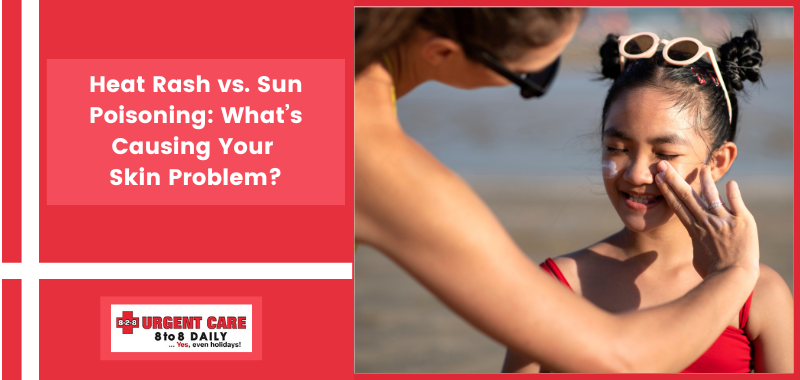


Summer’s here, and so is the sun! While we all love basking in those sunny rays, sometimes it’s easy to forget just how much damage they can do to our skin. Whether you're lounging by the pool or spending hours working outside, sun exposure can lead to painful skin conditions like heat rash and sun poisoning. But how do you know which one you’re dealing with?
Let’s break it down so you can spot the differences and know exactly how to treat each one.
Heat rash, also known as prickly heat, occurs when sweat becomes trapped under the skin due to blocked sweat glands, typically in hot, humid weather. It's especially common in babies, athletes, and individuals who sweat a lot in tight clothing.
This condition is more annoying than dangerous, but if left untreated, it can get uncomfortable fast, especially if you keep sweating.
Despite the name, sun poisoning isn’t actually a “poisoning,” it’s a severe form of sunburn caused by too much exposure to ultraviolet (UV) rays. It can cause deep damage to your skin and potentially affect your entire body.
This condition often shows up after a long day in the sun without proper protection. People with fair skin, light eyes, or a history of sunburn are especially at risk.
Let’s break it down and compare these two summer skin problems:
Now that you know what you're dealing with, here’s how to get some relief:
| Feature | Heat Rash | Sun Poisoning |
| Cause | Blocked sweat glands | UV radiation from the sun |
| Appearance | Small, red bumps or blisters | Red, blistering, swollen skin |
| Symptoms | Itchy, prickly, stinging | Fever, nausea, headache, dizziness |
| Location | Skin folds or area with friction | Sun-exposed areas like face, back, arms |
| Risk Factors | Humid weather, tight clothing, exercise | Fair skin, prolonged sun exposure, lack of sunscreen |
Some skin concerns need medical attention. Watch for these signs:
People who are immunocompromised, elderly, or very young (like infants) may also be more at risk for complications and should get checked sooner.
While both heat rash and sun poisoning can happen to anyone, there are some steps you can take to reduce your chances of having skin problems from sun exposure:
In the battle between heat rash and sun poisoning, knowing the difference is key to getting the right treatment and preventing more serious problems. Heat rash tends to be more localized and less severe, while sun poisoning can affect your entire body and requires more immediate attention. By staying cool, protecting your skin, and watching out for the signs, you can enjoy the summer sun without the skin mishaps!
Not sure if it's heat rash or sun poisoning? The experienced team at 8-2-8 Urgent Care can quickly evaluate your symptoms and provide fast, effective treatment to get your skin back to normal.
Get clarity and care, contact us or visit us today! Our friendly team members will walk you through our mobile self-check-in, from the comfort of your home and we will call you when it is your turn to come in for care.